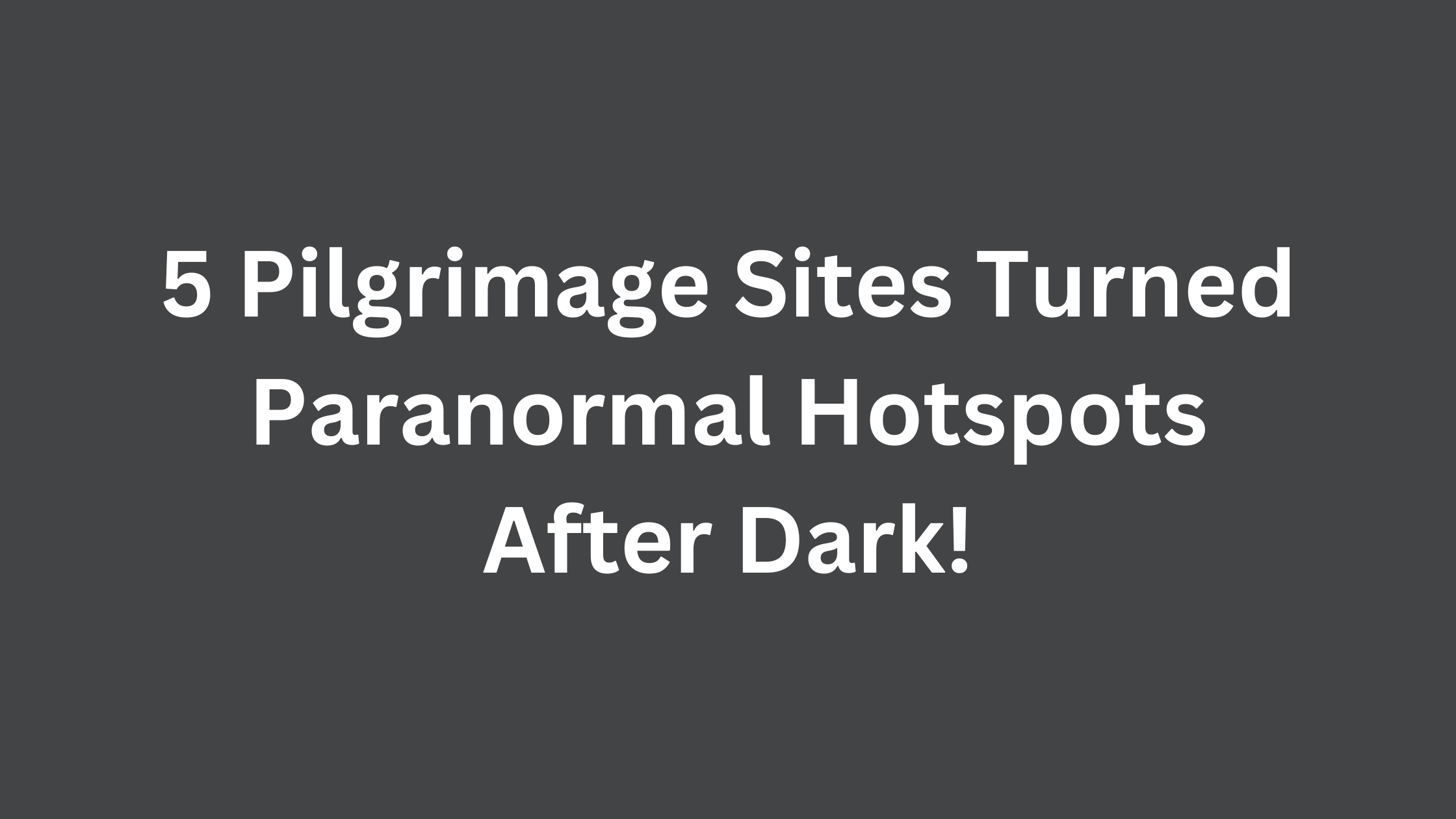Discover 5 revered pilgrimage sites around the world that become spine-chilling paranormal hotspots after dark. Below, we’ll explore the sacred and spooky dual nature of landmarks like England’s haunted Borley Rectory, the eerie Sedlec Ossuary in the Czech Republic, and more intriguing destinations immersed in chilling tales of ghosts and unexplained phenomena at nightfall. For the adventurous traveler drawn to the mysterious crossroads where spiritual history meets the supernatural.
Thanks to the International Drivers Association for help with this article.
From Sacred to Spooky: 5 Pilgrimage Sites Turned Paranormal Hotspots After Dark
“Seeing is believing, but sometimes the most real things in the world are the things we can’t see.” This famous quote, straight out of ‘The Polar Express’, could just as easily refer to the world of the supernatural as it does to the magic of Christmas. Paranormal activities, inexplicable phenomena, and ghostly encounters may all sound like the stuff of horror movies.
But for centuries, humans have been intrigued by what they can’t understand or rationalize. This fascination transcends into a strange intertwining of the superstitious and the spiritual, a mystifying blend that captures the imagination and tests the beliefs ordinarily held by many.
Let’s dive into five exceptional pilgrimage sites around the world characterized by deep spiritual significance. At night though, they take on a seemingly different aura after dark, turning into mysterious, often eerie, paranormal hotspots.
1. Borley Rectory, England
The former Victorian mansion in the village of Borley, Essex earned a reputation as the ‘most haunted house in England’ after numerous reports of ghostly activity surfaced beginning in 1863. Built on the site of a 12th century monastery, the rectory was home to unsettling phenomena like disembodied footsteps, phantom carriages, mysterious writings on walls, and recurring sightings of a headless specter, a nun, and a woman dressed in black.
Investigations by renowned psychic researcher Harry Price in the 1930s documented alleged seances, spirit messages, and possessed inhabitants, further fueling the notoriety of what he dubbed “the most haunted house in England.” While the rectory itself was destroyed by fire in 1939, the legends of restless spirits on the grounds persist, drawing paranormal investigators and ghost hunters to this day. The abandoned, overgrown site remains a point of intrigue for thrill-seekers and enthusiasts of the supernatural.
2. Sedlec Ossuary, Czech Republic
The Sedlec Ossuary is an unusual Roman Catholic chapel located in a suburb of Kutná Hora in the Czech Republic. Nestled beneath the Cemetery Church of All Saints, this small crypt contains the artfully arranged skeletons of between 40,000 and 70,000 people.
In 1278, Henry, the abbot of the Sedlec monastery, returned from a pilgrimage to the Holy Land with a handful of dirt from Golgotha, which he sprinkled over the abbey cemetery. This act helped make Sedlec a highly desirable burial site throughout Central Europe in the centuries that followed.
After the Black Death and the bloody Hussite Wars filled the grounds with mass graves in the 14th and 15th centuries, a Gothic church was built in the cemetery with a lower level ossuary to hold the unearthed bones. Around 1400, the gruesome task of stacking and organizing the skeletons fell to a half-blind monk who arranged them into macabre works of art.
Today, the ossuary draws both reverent pilgrims and curious visitors who come to see the peculiar bone arrangements and chandeliers that adorn the crypt. This sacred site with a morbid twist has appeared in numerous films and shows, attracting those intrigued by its blend of spiritual history and the grotesque. As darkness falls, it becomes even more an eerie and ghostly place.
3. Lourdes, France
Lourdes, nestled in the Pyrenees mountains of southern France, is revered as one of Catholicism’s most sacred pilgrimage sites. It rose to prominence in 1858 when a 14-year-old peasant girl named Bernadette Soubirous claimed to have experienced 18 visions of the Virgin Mary in a grotto along the Gave de Pau river.
Bernadette described the apparition as a beautiful lady who revealed herself to be the “Immaculate Conception.” The lady instructed Bernadette to dig near the grotto, unleashing a spring whose waters have become associated with miraculous healings. Since then, Lourdes has been the site of countless unexplained cures and paranormal events.
At nightfall, the atmosphere around the grotto takes on an aura of mystery. Pilgrims have reported ghostly figures, strange lights, unearthly scents, and mystical sensations that defy scientific explanation. The convergence of sacred spiritual history with inexplicable phenomena has imbued Lourdes with an intriguing dual nature after dark, where faith and the supernatural seem to intersect.
4. Bhangarh Fort, India
Nestled in the Aravalli Hills of Rajasthan, the ruined city of Bhangarh has a dramatic duality. By day, it is an impressive 16th century fort and UNESCO heritage site known for its well-preserved palaces, temples, and bazaars. But as darkness falls, an ominous aura settles over the abandoned grounds.
Locals shun the fort after sunset due to legends of a doomed priest’s curse and numerous accounts of ghosts, unexplained noises, and paranormal activity. Visitors have reported experiencing an unnerving sense of being watched, feelings of dread, ominous shadows, and getting inexplicably lost in the twisting corridors.
The archeological site’s creepy reputation at night is so renowned that the Archaeological Survey of India has placed a sign forbidding entry between sunset and sunrise. For history buffs and ghost hunters alike, Bhangarh by moonlight is an intriguing intersection of heritage and haunting.
5. Aokigahara Forest, Japan
Nestled on the northwest base of Mount Fuji, Aokigahara Forest is a beautiful sea of trees by day, with icy caverns and lava formations attracting tourists and hikers. But as darkness falls, an ominous aura settles over the dense forest.
Nicknamed the “Suicide Forest,” Aokigahara has sadly become one of the world’s most popular sites for taking one’s life. Over 100 bodies are recovered from the forest each year. Locals believe the restless spirits, or yūrei, of the departed haunt the woods after dark. Visitors have reported encountering ghostly whispers, footsteps, and apparitions among the trees at night. Compasses spinning erratically and an unsettling sense of being followed are also common accounts.
For adventurers drawn to the mysterious crossroads between natural beauty and paranormal activity, Aokigahara offers an intriguing dual nature. However, its tragic past must be remembered, and exploration conducted respectfully. The forest transformed by darkness serves as a solemn reminder of the value of all human life.
A Word of Advice for Visiting Sacred Sites with Paranormal Reputations
“Traveling to such locations can be an exciting experience, yet it requires caution, respect, and sensitivity,” notes Julianna Marshall, an International Drivers Association Travel Expert.
“These places have cultural and often spiritual significance, so following all rules and regulations and behaving appropriately is important. Carry identification, notify someone about your whereabouts, and keep emergency contact numbers ready as a precaution.”
The Veil Between Reality and the Paranormal Transforms at Night
There’s a certain mystique surrounding these spiritual landmarks – tales of spectral sightings and inexplicable phenomena that are enough to attract—and occasionally frighten—the most adventurous of travelers. A pilgrimage site, immersed in its sacredness during daylight hours, can metamorphose into a chilling, otherworldly place once darkness descends, suggesting that the veil between reality and the paranormal becomes quite thin at night.
Are these simply exaggerated stories or ancient occurrences so deeply woven into popular folklore that they’ve become accepted as truth? Is it purely psychological, orchestrated by the inherent human fear of the unknown? Or is there actually a supernatural dimension humans are yet unable to decipher?
As Winston Churchill wisely remarked: “The farther backward you can look, the farther forward you can see.” Perhaps by digging deeper into the past, we might uncover clues to these questions that continue to mystify humanity. So, whether you’re a spirit-chasing adventurer or a lover of historical lore, these dual-nature destinations offer a deep dive into a realm where the sacred intertwines with the scary—just remember to tread cautiously.






